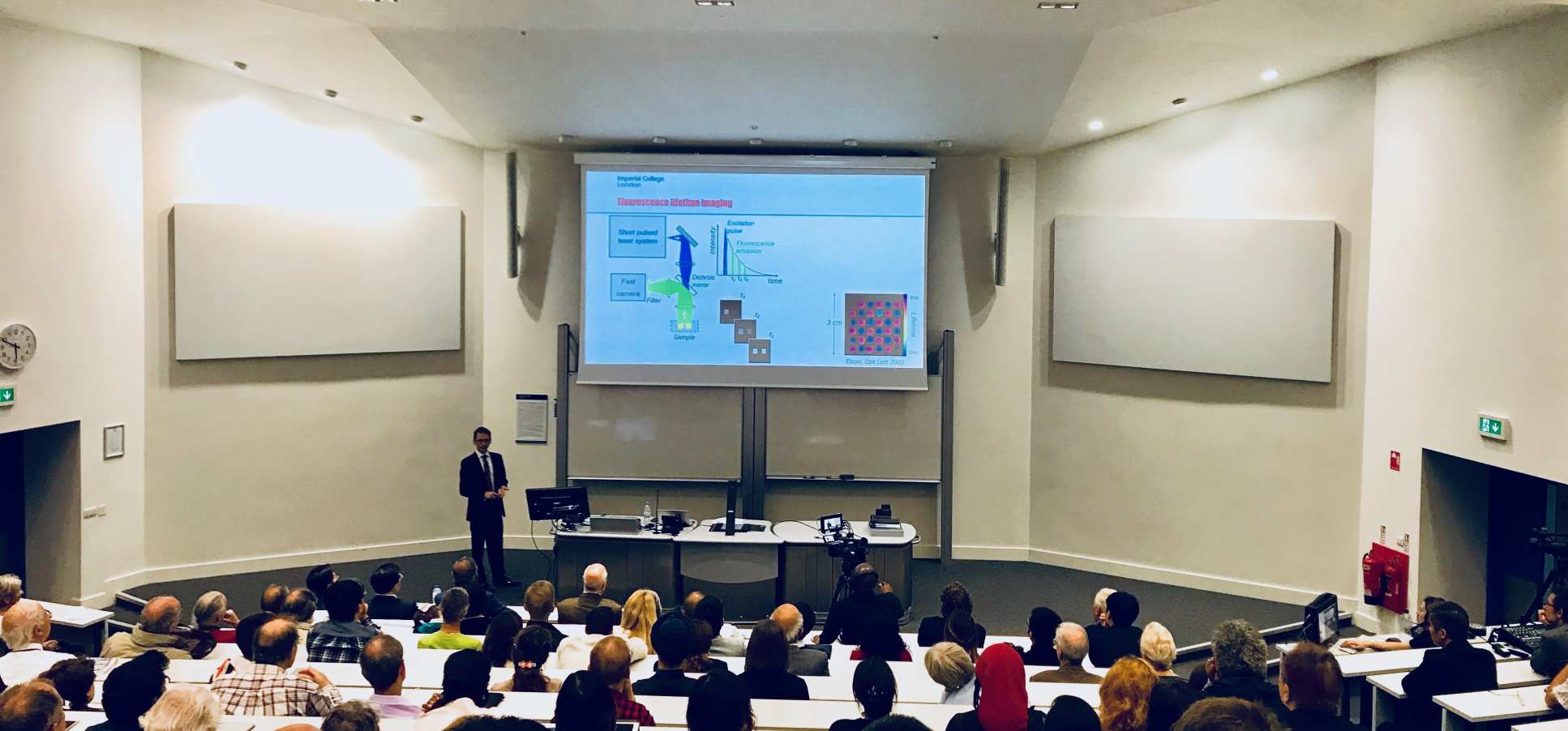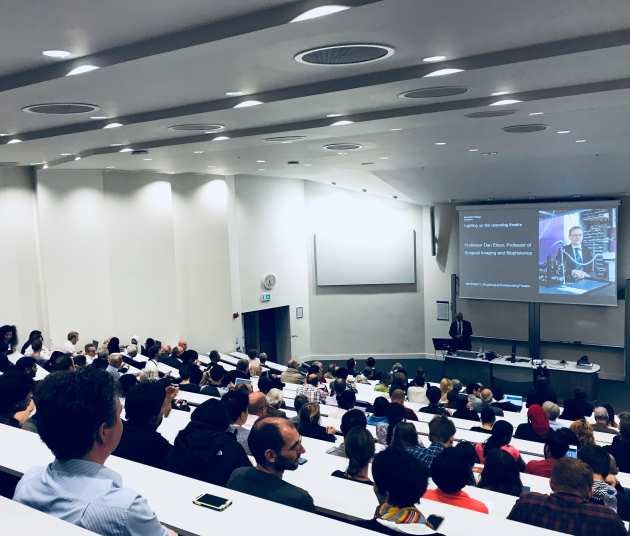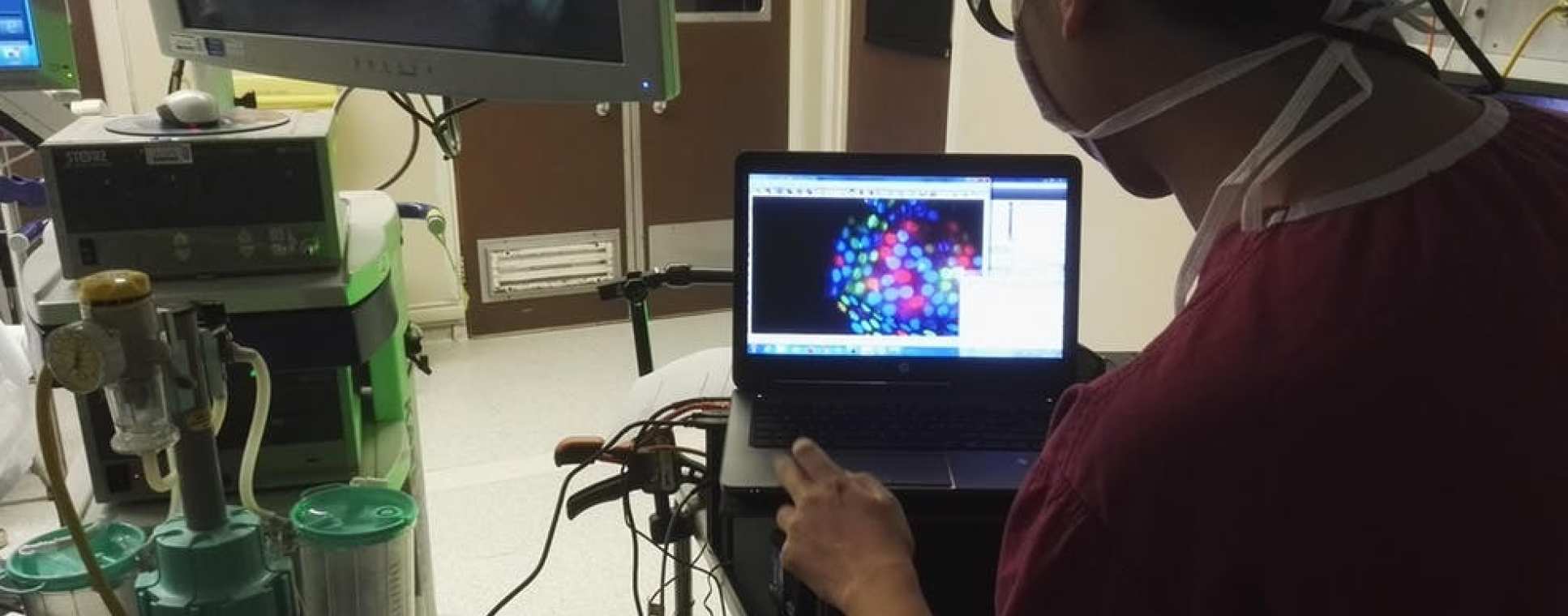The Distinguished Lecture Series invites leading researchers in the fields of medical robotics, imaging and sensing from around the world as well as from the Hamlyn Centre for Robotic Surgery to present their work at Imperial College London.
Lighting up the operating theatre

Professor Daniel Elson
Professor of Surgical Imaging and Biophotonics
Date: Wednesday 12 September 2018
Time: 17.30
Venue: Lecture Theatre 200, City and Guilds Building,
Imperial College London, South Kensington Campus, London, SW7 2AZ (building no 28 on the map).
The lecture is free to attend and open to all, but registration is required in advance - book your ticket on Eventbrite
A drinks reception will follow the lecture at 18.30 on the Level 2 Concourse outside the lecture theatre.
This lecture is now available to review online.
Magnetic Resonance Imaging: Visions of Life
Abstract:
 From the landmark breakthroughs in keyhole surgery to advances in operating theatre robotics, imaging and optics have proved key to equipping today’s surgeons with the information and tools to perform more precise, effective surgery. Light-based technologies such as fluorescence, multispectral and polarisation resolved imaging are opening up the possibility for in-vivo tissue characterisation and image-guided surgery using live information feedback. Rather than relying on the naked eye or preoperative MRI or CT scan data, surgeons in the future operating theatre will see an augmented reality view of the margins of diseased tissues or tumours at the time of the surgery. However, there are challenges, particularly in getting devices in patients, obtaining regulatory approval and analysing the output data.
From the landmark breakthroughs in keyhole surgery to advances in operating theatre robotics, imaging and optics have proved key to equipping today’s surgeons with the information and tools to perform more precise, effective surgery. Light-based technologies such as fluorescence, multispectral and polarisation resolved imaging are opening up the possibility for in-vivo tissue characterisation and image-guided surgery using live information feedback. Rather than relying on the naked eye or preoperative MRI or CT scan data, surgeons in the future operating theatre will see an augmented reality view of the margins of diseased tissues or tumours at the time of the surgery. However, there are challenges, particularly in getting devices in patients, obtaining regulatory approval and analysing the output data.
In his inaugural lecture, Daniel Elson will talk through a career that has mirrored the typical innovation translation pathway - from a PhD in laser physics, and time spent in the Faculty of Engineering developing imaging tools for key hole surgery, a move to the Division of Surgery saw him work directly with surgeons to begin translating those technologies into image guidance tools. He will discuss progress made developing diagnostic methods and technologies, and the value of adopting a clinical, rather than purely technological driven, approach to innovation and problem solving, working with surgeons to identify challenges today and tomorrow.
Biography:
Daniel Elson is a Professor of Surgical Imaging and Biophotonics in the Hamlyn Centre for Robotic Surgery, Institute of Global Health Innovation and Department of Surgery and Cancer, Imperial College London. He completed an MSci and PhD in Physics at Imperial in 1999 and 2003 and became a Lecturer in the Institute of Biomedical Engineering in 2005.
His research interests are based around the development and application of photonics technology with endoscopy for surgical imaging applications, including multispectral imaging, polarization-resolved imaging, fluorescence imaging, and the use of fluorescently labelled gold nanorods for theranostics. Further projects include work on the development of illumination and vision systems for endoscopy combining miniature light sources such as LEDs and laser diodes with computer vision techniques for structured lighting and tissue surface reconstruction as well as the use of robotic guidance of optical probes. These devices are finding application in minimally invasive surgery and in the development of new flexible robotic assisted surgery systems. These projects are funded by sources including EPSRC, ERC, H2020, NIHR, SBRI and the Wellcome Trust. He has published over ninety-five peer reviewed journal articles, one edited book, twelve book chapters and has contributed to over three hundred conferences.
Past lectures
15th November 2016: Imaging the Malnourished Gut
Imaging the mucosal barrier in the malnourished gut
Professor Paul Kelly
Professor of Tropical Gastroenterology
Barts and The London School of Medicine and Dentistry & The University of Zambia
15:30 - 16:30 Tuesday 15 November 2016
Meeting Rooms 1 & 2, Level 4 Bessemer Building,
South Kensington Campus, Imperial College London
Abstract: Environmental enteric dysfunction (EED) is a poorly understood inflammatory condition of the small intestine that is endemic in many developing countries. EED is strongly associated with growth stunting and other poor developmental outcomes in children, and causes impairments in both nutrient absorption and intestinal barrier function. In this lecture, Professor Kelly will introduce EED in detail and will discuss his work using fluorescence endomicroscopy and transcriptomic analysis to assess the structural and functional changes that occur in the gut as a result of this disease.
Bio: Paul Kelly is Professor of Tropical Gastroenterology at Barts and The London School of Medicine and Dentistry and head of the Tropical Gastroenterology and Nutrition group within the University of Zambia School of Medicine. His research centres on the study of environmental enteric dysfunction (EED).
13th May 2016: Biomechanical Tissue Modelling
Paradigm shift in biomechanics: no more research on mechanical properties of tissues!
Professor Karol Miller
Winthrop Professor
School of Mechanical and Chemical Engineering
The University of Western Australia
12:00 - 13:00 Friday 13 May 2016
ChemEng LT 3, ACE Extension
South Kensington Campus, Imperial College London
Abstract: It is now recognised that the most urgent task of biomechanists is to devise methods for clinically-relevant patient-specific modelling. A large proportion of the biomechanics community believes that the main obstacle in creating patient-specific models is the difficulty (or impossibility?) of measuring patient-specific properties of tissues to be used in biomechanical models.
For about ten years ISML has advocated a complete refocus of biomechanical research away from describing mechanical properties of tissues. We postulate that instead we need to reformulate computational mechanics problems in such a way that the results are weakly sensitive to the variation in mechanical properties of simulated continua. This suggestion constitutes a paradigm shift in the field and has encountered strong resistance of the more traditionally inclined members of the biomechanics community.
In this seminar I will describe briefly how ISML members’ thinking on this completely new approach to biomechanics has evolved over the years. I will also demonstrate the success of our new approach using examples from the fields of image-guided neurosurgery and vascular biomechanics.
Bio: Karol Miller studied Applied Mechanics and received a PhD in Robotics from Warsaw University of Technology in 1994, and Doctorate of Science (Habilitation) in Biomechanics from the Polish Academy of Sciences in 2003. He has been with UWA for twenty years. In 2002 he established the Intelligent Systems for Medicine Laboratory. ISML’s mission is to work towards improving clinical outcomes through appropriate use of technology. It runs exciting research projects funded by the Australian Research Council, the National Health and Medical Research Council (Australia), the National Institute of Health (USA) and other national and international agencies. The overall objective of his research is to help creating methods and tools which will enable a new exciting era of personalised medicine. He is best known for his work on biomechanics of soft tissues. His current research interests include computational biomechanics for medicine and numerical methods, with applications to surgical simulation, image-guided surgery and, surprise, geomechanics. His research and teaching have been recognised by multiple awards, including the Humboldt Research Award, NVIDIA GPU Computing Champion Award, the Simulation Industry Association Australia Award, the Sir Charles Julius Award, the Polish Prime Minister Award, the UWA Faculty of Engineering Computing and Mathematics Teaching Award and the UWA Student Guild Choice Award.
23rd March 2016: Intra-articular BCP Crystals in Osteoarthritis
5th November 2015: Biomimetic Microfluidics
Biomimetic Microfluidics – The Key to Revolutionising the Performance of Autonomous Chem/Bio-Sensing Platforms
Prof Dermot Diamond
Director of the National Centre for Sensor Research at Dublin City University
14:00 Thursday 5th November 2015
Meeting Rooms 1 & 2 (B402 & B403), Level 4 Bessemer Building
South Kensington Campus, Imperial College London
Abstract:
Imagine a world in which issues related to long-term (months to years) reliability of chem/bio-sensing platforms have been solved, and devices capable of carrying out complex chem/bio-functions in an autonomous manner are ubiquitously available. The potential impact of these technologies socially and economically is enormous, and the demand will be universal, driven by an infinite range of applications. Devices will perform complex analytical measurements while located in remote and environmentally hostile locations, such as the deep oceans, or inside the human body. Their capabilities will go far beyond those of existing devices; chemical sensors, biosensors, lab-on-chip (LOC) systems or autonomous analysers, that cannot deliver the price-performance required for reliable long-term (years) autonomous in-situ operation. Revolutionary device improvements are required to meet this vision, and it is becoming clear that these improvements require a fundamental move towards devices based on bio-inspired approaches. For example, future instrument fluidics will have a much more active role beyond the current tasks of transporting samples, mixing reagents, and cleaning. Much like the circulation systems in living entities, these circulation systems will perform advanced functions, like using mobile micro-scaled biomimetic agents to detect, spontaneously migrate to, and repair damaged channels or fluidic components in order to maintain functional integrity of the device. These strategies, if successful, will be broadly disruptive across many application domains, from chronic disease management to environmental monitoring. In this paper, I will present ideas and strategies through which this exciting vision might be advanced via an exciting combination of stimuli-responsive materials, emerging technologies for precise control of 3D materials morphology (to nanoscale dimensions), and state of the art characterization and visualization techniques.
Biography:
Dermot Diamond received his Ph.D. and D.Sc. from Queen’s University Belfast (Chemical Sensors, 1987, Internet Scale Sensing, 2002), and was Vice-President for Research at Dublin City University (2002-2004). He has published over 300 peer-reviewed papers in international journals, is a named inventor in 19 patents, and is co-author and editor of five books. He was director (2007-2015) and founding member of the National Centre for Sensor Research (www.ncsr.ie) at Dublin City University, and an SFI-funded investigator in the INSIGHT Centre (http://www.insight-centre.org). In 2002, he was awarded the inaugural silver medal for Sensor Research by the Royal Society of Chemistry, London, and in 2006 he received the DCU President’s Award for research excellence, and in 2015 he was received the president’s award for innovation. In May 2014, in recognition of his academic contributions and achievements, he was admitted to Membership of the Royal Irish Academy. In April 2015 he was awarded the Boyle Higgins Gold Medal by the Institute of Chemistry of Ireland in recognition of his research achievements. His research is focused on the fundamental science of stimuli responsive polymers, the development of futuristic autonomous chemical sensing platforms, and the use of analytical devices and sensors as information providers for wireless networked systems i.e. building a continuum between the digital and molecular worlds.
Further details of his research can be found at www.dcu.ie/chemistry/asg.
Contact Us
General enquiries
hamlyn@imperial.ac.uk
Facility enquiries
hamlyn.facility@imperial.ac.uk
The Hamlyn Centre
Bessemer Building
South Kensington Campus
Imperial College
London, SW7 2AZ
Map location


